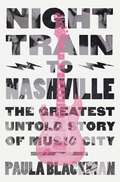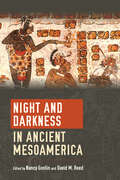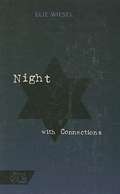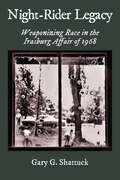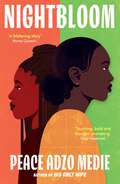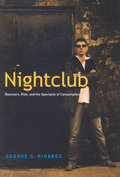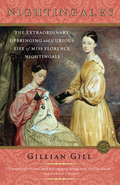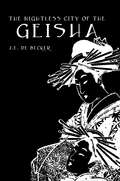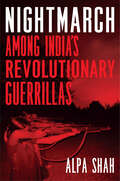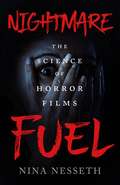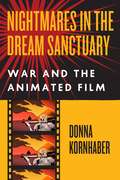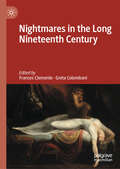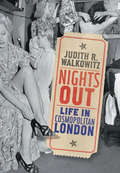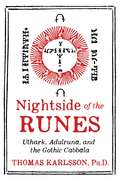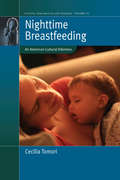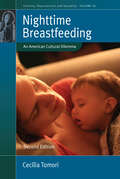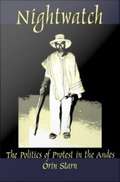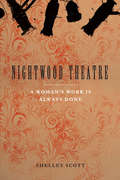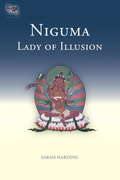- Table View
- List View
Night Train to Nashville: The Greatest Untold Story of Music City
by Paula BlackmanSet against the backdrop of Jim Crow, Night Train to Nashville takes readers behind the curtain of one of music's greatest untold stories during the era of segregation and Civil Rights.In another time and place, E. Gab Blackman and William Sousa "Sou" Bridgeforth might have been as close as brothers, but in 1950s Nashville they remained separated by the color of their skin. Gab, a visionary yet opportunistic radio executive, saw something no one else did: a vast and untapped market with the R&B scene exploding in Black clubs across the city. He defied his industry, culture, government, and even his own family to broadcast Black music to a national audience.Sou, the popular kingpin of Black Nashville and a grandson of slaves, led this movement into the second half of the twentieth century as his New Era Club on the Black side of town exploded in the aftermath of this new radio airplay. As the popularity of Black R&B grew, integrated parties and underground concerts spread throughout the city, and this new scene faced a dangerous inflection point: Could a segregated society ever find true unity?Taking place during one of the most tumultuous times in US history, Night Train to Nashville explores how one city, divided into two completely different and unequal communities, demonstrated the power of music to change the world.
Night and Darkness in Ancient Mesoamerica
by Nancy Gonlin David M. ReedNight and Darkness in Ancient Mesoamerica is the first volume to explicitly incorporate how nocturnal aspects of the natural world were imbued with deep cultural meanings and expressed by different peoples from various time periods in Mexico and Central America. Material culture, iconography, epigraphy, art history, ethnohistory, ethnographies, and anthropological theory are deftly used to illuminate dimensions of darkness and the night that are often neglected in reconstructions of the past. The anthropological study of night and darkness enriches and strengthens the understanding of human behavior, power, economy, and the supernatural. In eleven case studies featuring the residents of Teotihuacan, the Classic period Maya, inhabitants of Rio Ulúa, and the Aztecs, the authors challenge archaeologists to consider the influence of the ignored dimension of the night and the role and expression of darkness on ancient behavior. Chapters examine the significance of eclipses, burials, tombs, and natural phenomena considered to be portals to the underworld; animals hunted at twilight; the use and ritual meaning of blindfolds; night-blooming plants; nocturnal foodways; fuel sources and lighting technology; and other connected practices. Night and Darkness in Ancient Mesoamerica expands the scope of published research and media on the archaeology of the night. The book will be of interest to those who study the humanistic, anthropological, and archaeological aspects of the Aztec, Maya, Teotihuacanos, and southeastern Mesoamericans, as well as sensory archaeology, art history, material culture studies, anthropological archaeology, paleonutrition, socioeconomics, sociopolitics, epigraphy, mortuary studies, volcanology, and paleoethnobotany. Contributors: Jeremy Coltman, Christine Dixon, Rachel Egan, Kirby Farah, Carolyn Freiwald, Nancy Gonlin, Julia Hendon, Cecelia Klein, Jeanne Lopiparo, Brian McKee, Jan Marie Olson, David M. Reed, Payson Sheets, Venicia Slotten, Michael Thomason, Randolph Widmer, W. Scott Zeleznik
Night of Stone: Death and Memory in Twentieth-Century Russia
by Catherine MerridaleRussian history with an emphasis on personal tragedy.
Night of the Amber Moon
by Helen Dunlap NewtonIzzy just wants to be a normal eleven-year-old kid with friends, less homework and a dad that doesn't turn mean when he drinks. Having a birthday party would help but how does she convince her parents when there's never enough money? None of it matters when her family's house burns to the ground and her father doesn't escape the flames. Even worse is the guilt she feels, thinking the fire is her fault. Afraid to tell anyone about the cause of the fire, Izzy obsesses about the old brick theater next to the family's store and the strange noises from deep inside the building. Will an elusive cat, the creepy theater, and a strange old lady guide her to the forgiveness she so desperately needs?
Night, with Connections
by Elie WieselWiesel's account of his survival as a teenager in the Nazi death camps, including a new preface is which he reflects on the enduring importance of Night and his lifelong, passionate dedication to ensuring that the world never forgets man's capacity for inhumanity to man.
Night-Rider Legacy: Weaponizing Race in the Irasburg Affair of 1968
by Gary G. ShattuckA study of the impact and consequences caused by the use of inflammatory racially-related language during a police investigation conducted by the Vermont State Police. Beginning in 1968 with the Irasburg Affair when a White man fired shotgun blasts into a home occupied by a Black family, the story describes in detail the course of the investigation. Adverse publicity about the VSP's work alleging racism within its ranks ensued resulting in its managers withdrawing from public view and refusing to work with the legislature in the next years causing significant internal problems. They finally came to the forefront in 1979 when a despondent trooper committed suicide at the state house in Montpelier in an event called the Router Bit Affair that led to significant reforms beginning in 1980.
Night-time and Sleep in Asia and the West: Exploring the Dark Side of Life (Anthropology of Asia)
by Brigitte Steger Lodewijk BruntIdeas and practices concerning sleep and night-time are constantly changing and widely varied in different cultures and societies. What we do during the day and night is the result of much political struggle. Trade unions, political parties, entrepreneurs, leaders and schools boards, all have an interest in questions of timing for the opening and closing of shops, the starting hours of schools and factories, and the number of hours people have to work and sleep. By drawing together comparative case studies from countries in both Asia and Europe, Night-time and Sleep in Asia and the West allows the reader to track the differences in the cultural importance given to the night, and to compare the ways in which the challenges and opportunities of modernity have been played out in the East and the West.
Nightbloom: LONGLISTED FOR THE WOMEN'S PRIZE FOR FICTION 2024
by Peace Adzo Medie'Remarkable' Chika Unigwe, author of On Black Sisters' Street AKORFA AND SELASI WERE ONCE INSEPARABLE. NOW, THEY MUST REPAIR THEIR BROKEN RELATIONSHIP OR LOSE EACH OTHER FOREVER. Growing up in the same small Ghanaian town, Selasi and Akorfa were more than just cousins, they were best friends. The girls shared everything: their dreams, their desires, their every secret. But as they enter their teens Selasi begins to change, until Akorfa barely recognises the sullen, withdrawn girl she once knew so well. Years go by before they cross paths again, and their lives look very different now. Although they are separated by continents, they have each found success in their careers: Akorfa works in international development in the US; Selasi is a restaurateur running the hottest spot in Accra. It takes a crisis to pull them back together, forcing both women to confront shocking secrets and childhood trauma that neither one has been willing to address. Now they must bridge the gulf between them to stop history repeating itself. From the author of Reese's Book Club pick His Only Wife, Nightbloom is a powerful story about female friendship, the relationships that shape us and the people we never quite leave behind. 'I was hooked on Peace's writing! I found Nightbloom a blistering story, written with razor sharp precision.' Huma Qureshi, author of Things We Do Not Tell the People We Love
Nightclub
by George S. RigakosPeople go to nightclubs to see and be seen - to view others as aesthetic objects and to present themselves as objects of desire. Rigakos argues that this activity fuses surveillance and aesthetic consumption - it fetishizes bodies and amplifies social capital, producing violence and crises fuelled by alcohol. At closing time, patrons flow out of the insular haze of the nightclub and onto city streets, moving from private spectacle to public nuisance. Bouncers are thus both policing agents in the nighttime economy and the gatekeepers of an urban risk market - a site of circumscribed transgression and consumption that begins at the nightclub door.
Nightclub: Bouncers, Risk, and the Spectacle of Consumption
by George S. RigakosPeople go to nightclubs to see and be seen - to view others as aesthetic objects and to present themselves as objects of desire. Rigakos argues that this activity fuses surveillance and aesthetic consumption - it fetishizes bodies and amplifies social capital, producing violence and crises fuelled by alcohol. At closing time, patrons flow out of the insular haze of the nightclub and onto city streets, moving from private spectacle to public nuisance. Bouncers are thus both policing agents in the nighttime economy and the gatekeepers of an urban risk market - a site of circumscribed transgression and consumption that begins at the nightclub door.
Nightingales: Florence and Her Family
by Gillian GillFlorence Nightingale is history's most famous nurse, the epitome of gentle, nurturing femininity. But behind the public image of 'The Lady With the Lamp' was a brilliant, combative, complicated woman, struggling to escape a web of social prejudice and familial expectations. From girlhood, Florence wanted to dedicate her life to nursing in public hospitals, even though nursing was then work done only by women of the lowest classes. Florence's family were determined to stop her. Eventually Florence had her way, and her nursing mission took her to the filthy, disease-ridden military hospitals of Scutari and Balaclava. Her work during the Crimean War made her an international heroine, and thereafter she wielded an influence over public health policy that was unparalleled for a woman of the time. Radical in her ideas, eccentric in her way of life, Florence was often at war with her family, but love and loyalty always triumphed in the end. The other Nightingales adored and criticised her, understood and misread her, supported and thwarted her, defined and were defined by her. Gillian Gill's absorbing biography brings the dynamic and complicated social milieu of the Victorian age dramatically to life. Fascinating new light is shed not just on one of the era's most influential social figures, but on the entire era through which the young Florence and her family lived.
Nightless City Of Geisha
by De_BeckerFirst Published in 2005. Routledge is an imprint of Taylor & Francis, an informa company.
Nightmarch: Among India’s Revolutionary Guerrillas
by Alpa ShahAnthropologist Alpa Shah found herself in an active platoon of Naxalites—one of the longest-running guerrilla insurgencies in the world. The only woman, and the only person without a weapon, she walked alongside the militants for seven nights across 150 miles of dense, hilly forests in eastern India. Nightmarch is the riveting story of Shah's journey, grounded in her years of living with India’s tribal people, an eye-opening exploration of the movement’s history and future and a powerful contemplation of how disadvantaged people fight back against unjust systems in today’s world. The Naxalites have fought for a communist society for the past fifty years, caught in a conflict that has so far claimed at least forty thousand lives. Yet surprisingly little is known about these fighters in the West. Framed by the Indian state as a deadly terrorist group, the movement is actually made up of Marxist ideologues and lower-caste and tribal combatants, all of whom seek to overthrow a system that has abused them for decades. In Nightmarch, Shah shares some of their gritty untold stories: here we meet a high-caste leader who spent almost thirty years underground, a young Adivasi foot soldier, and an Adivasi youth who defected. Speaking with them and living for years with villagers in guerrilla strongholds, Shah has sought to understand why some of India’s poor have shunned the world’s largest democracy and taken up arms to fight for a fairer society—and asks whether they might be undermining their own aims. By shining a light on this largely ignored corner of the world, Shah raises important questions about the uncaring advance of capitalism and offers a compelling reflection on dispossession and conflict at the heart of contemporary India.
Nightmare Fuel: The Science of Horror Films
by Nina NessethNightmare Fuel by Nina Nesseth is a pop-science look at fear, how and why horror films get under our skin, and why we keep coming back for more.Do you like scary movies?Have you ever wondered why?Nina Nesseth knows what scares you. She also knows why.In Nightmare Fuel, Nesseth explores the strange and often unexpected science of fear through the lenses of psychology and physiology. How do horror films get under our skin? What about them keeps us up at night, even days later? And why do we keep coming back for more?Horror films promise an experience: fear. From monsters that hide in plain sight to tension-building scores, every aspect of a horror film is crafted to make your skin crawl. But how exactly do filmmakers pull this off? The truth is, there’s more to it than just loud noises and creepy images.With the affection of a true horror fan and the critical analysis of a scientist, Nesseth explains how audiences engage horror with both their brains and bodies, and teases apart the elements that make horror films tick. Nightmare Fuel covers everything from jump scares to creature features, serial killers to the undead, and the fears that stick around to those that fade over time.With in-depth discussions and spotlight features of some of horror’s most popular films—from classics like The Exorcist to modern hits like Hereditary—and interviews with directors, film editors, composers, and horror academics, Nightmare Fuel is a deep dive into the science of fear, a celebration of the genre, and a survival guide for going to bed after the credits roll.“An invaluable resource, a history of the horror genre, a love letter to the scary movie—it belongs on any horror reader’s bookshelf.” —Lisa Kröger, Bram Stoker Award-winning author of Monster, She WroteAt the Publisher's request, this title is being sold without Digital Rights Management Software (DRM) applied.
Nightmares in the Dream Sanctuary: War and the Animated Film
by Donna KornhaberIn 2008, Waltz with Bashir shocked the world by presenting a bracing story of war in what seemed like the most unlikely of formats—an animated film. Yet as Donna Kornhaber shows in this pioneering new book, the relationship between animation and war is actually as old as film itself. The world’s very first animated movie was made to solicit donations for the Second Boer War, and even Walt Disney sent his earliest creations off to fight on gruesome animated battlefields drawn from his First World War experience. As Kornhaber strikingly demonstrates, the tradition of wartime animation, long ignored by scholars and film buffs alike, is one of the world’s richest archives of wartime memory and witness. Generation after generation, artists have turned to this most fantastical of mediums to capture real-life horrors they can express in no other way. From Chinese animators depicting the Japanese invasion of Shanghai to Bosnian animators portraying the siege of Sarajevo, from African animators documenting ethnic cleansing to South American animators reflecting on torture and civil war, from Vietnam-era protest films to the films of the French Resistance, from firsthand memories of Hiroshima to the haunting work of Holocaust survivors, the animated medium has for more than a century served as a visual repository for some of the darkest chapters in human history. It is a tradition that continues even to this day, in animated shorts made by Russian dissidents decrying the fighting in Ukraine, American soldiers returning from Iraq, or Middle Eastern artists commenting on the Israeli-Palestinian conflict, the Arab Spring, or the ongoing crisis in Yemen. Nightmares in the Dream Sanctuary: War and the Animated Film vividly tells the story of these works and many others, covering the full history of animated film and spanning the entire globe. A rich, serious, and deeply felt work of groundbreaking media history, it is also an emotional testament to the power of art to capture the endurance of the human spirit in the face of atrocity.
Nightmares in the Long Nineteenth Century
by Frances Clemente Greta ColombaniFrom Johann Heinrich Füssli’s 1781 oil painting The Nightmare, which was to become the iconic image of a newly emergent sensibility, to the first psychoanalytic studies culminating in “On the Nightmare” by Ernest Jones, first published in 1911, the long nineteenth century was characterised by a pervasive fascination with nightmares, both as frightening dreams and, in their personified form, evil spirits or monstrous creatures. This volume investigates the extensive and multifaceted presence of nightmares in the literature and culture of this period from a cross-disciplinary and cross-national perspective, shedding new light on the remarkably widespread nature of the nineteenth-century interest in nightmares as well as on common threads and features that inform and animate it. Its contributions by scholars from different fields reveal how nineteenth-century representations of nightmare, across and beyond Europe, explored fundamental questions about the limits of consciousness and reason, the complex interplay of body and mind, the elusive boundaries between self and other, and the dread of alterity, giving voice to deep-rooted fears and anxieties in a period when these notions were undergoing radical rethinking.
Nights Out: Life in Cosmopolitan London
by Judith R. WalkowitzLondon's Soho district underwent a spectacular transformation between the late Victorian era and the end of the Second World War. This title shows how the area's foreignness, liminality, and porousness were key to the explosion of culture and development of modernity in the first half of the twentieth century
Nightside of the Runes: Uthark, Adulruna, and the Gothic Cabbala
by Thomas KarlssonReveals the occult wisdom and multidimensional layers of meaning hidden in the Nordic Rune stones • Explores the practice of the Uthark divination system encoded within the traditional exoteric Futhark system of reading the runes • Traces the relationship between the rune stones and numerology, the Cabbala, alchemy, Gothicism, and sigil magic • Examines the history of the runes and the ancient spiritual mysticism of Odin Uncovering the dark side of the Nordic rune stones hidden beneath their traditional interpretation, Swedish scholar and runologist Thomas Karlsson examines the rune work of Swedish mystic and runologist Johannes Bureus (1568-1652) and professor Sigurd Agrell (1881-1937), both of whom devoted their lives to uncovering the secret uses of rune stones concealed from all but the highest initiates. Karlsson begins by examining the Uthark system of divination--the Left Hand Path of the runes--that lies hidden under the traditional Futhark system. According to the lore of Uthark, a cryptographic ruse was used to make it impossible for the uninitiated to know the true order of the runes. Exploring Agrell’s decryption of the Uthark system, Karlsson reveals similarities between the numerology of ancient mystery cults and the Runic tradition. He explains the multidimensional meaning of each rune from the Uthark perspective, their relationships with the nine worlds of Norse cosmogony, and the magical powers of rune-rows and the three aettir rune groupings. He details how to create your own magically-charged runes, direct and activate the force of the runes, and use them for rune meditation, divination, sigil magic, galders (power songs), and rune yoga. Karlsson also examines the secret dimensions of the 15 “noble” runes, the Adulrunes, based on the theories of Johannes Bureus. Using his knowledge of the Cabbala and alchemy, Bureus created magical symbols with the Adulrunes as well as one symbol containing all 15 Adulrunes, which Bureus called the “Adulruna.” Karlsson explains Bureus’ spiritual system of initiation, the Gothic Cabbala, revealing the connections between old Norse wisdom and the Cabbala. He explores Bureus’ Adulrune practices and explains how Bureus outlined seven levels of meaning for each rune, with those initiated into the highest rune levels able to conjure spirits and raise the dead. Covering more than just rune practices, Karlsson’s exploration of the dark or night side of the runes provides a comprehensive guide to Norse spirituality and the ancient spiritual mysticism of Odin.
Nighttime Breastfeeding: An American Cultural Dilemma (Fertility, Reproduction and Sexuality: Social and Cultural Perspectives #26)
by Cecília TomoriNighttime for many new parents in the United States is fraught with the intense challenges of learning to breastfeed and helping their babies sleep so they can get rest themselves. Through careful ethnographic study of the dilemmas raised by nighttime breastfeeding, and their examination in the context of anthropological, historical, and feminist studies, this volume unravels the cultural tensions that underlie these difficulties. As parents negotiate these dilemmas, they not only confront conflicting medical guidelines about breastfeeding and solitary infant sleep, but also larger questions about cultural and moral expectations for children and parents, and their relationship with one another.
Nighttime Breastfeeding: An American Cultural Dilemma (Fertility, Reproduction and Sexuality: Social and Cultural Perspectives)
by Cecília TomoriNew parents in the United States are caught between responding to infant needs for closeness and breastfeeding, and cultural and medical norms that emphasize solitary sleep. This anthropological investigation shows that nighttime closeness and breastfeeding are the evolutionary and cross-cultural norm, but recent sociocultural shifts produced novel ideals of separation. The book uncovers how breastfeeding parents rework these cultural ideals. In this new edition, the author describes shifting medical guidance that increasingly supports breastfeeding yet remains largely separated from infant sleep guidance. The volume also provides a path towards more equitable approaches to nighttime infant care grounded in reproductive justice.
Nightwatch: The Politics of Protest in the Andes
by Orin StarnOrganized in the mid-1970s as a means of communal protection against livestock rustling and general thievery in Peru's rugged northern mountains, the rondas campesinas (peasants who make the rounds) grew into an entire system of peasant justice and one of the most significant Andean social movements of the late twentieth century. Nightwatch is the first full-length ethnography and the only study in English to examine this grassroots agrarian social movement, which became a rallying point for rural pride. Drawing on fieldwork conducted over the course of a decade, Orin Starn chronicles the historical conditions that led to the formation of the rondas, the social and geographical expansion of the movement, and its gradual decline in the 1990s. Throughout this anecdotal yet deeply analytical account, the author relies on interviews with ronda participants, villagers, and Peru's regional and national leaders to explore the role of women, the involvement of nongovernmental organizations, and struggles for leadership within the rondas. Starn moves easily from global to local contexts and from the fifteenth to the twentieth century, presenting this movement in a straightforward manner that makes it accessible to both specialists and nonspecialists. An engagingly written story of village mobilization, Nightwatch is also a meditation on the nature of fieldwork, the representation of subaltern people, the relationship between resistance and power, and what it means to be politically active at the end of the century. It will appeal widely to scholars and students of anthropology, Latin American studies, cultural studies, history, subaltern studies, and those interested in the politics of social movements.
Nightwork: Sexuality, Pleasure, and Corporate Masculinity in a Tokyo Hostess Club
by Anne AllisonIn Nightwork, Anne Allison opens a window onto Japanese corporate culture and gender identities. Allison performed the ritualized tasks of a hostess in one of Tokyo's many "hostess clubs": pouring drinks, lighting cigarettes, and making flattering or titillating conversation with the businessmen who came there on company expense accounts. Her book critically examines how such establishments create bonds among white-collar men and forge a masculine identity that suits the needs of their corporations. Allison describes in detail a typical company outing to such a club—what the men do, how they interact with the hostesses, the role the hostess is expected to play, and the extent to which all of this involves "play" rather than "work. " Unlike previous books on Japanese nightlife, Allison's ethnography of one specific hostess club (here referred to as Bijo) views the general phenomenon from the eyes of a woman, hostess, and feminist anthropologist. Observing that clubs like Bijo further a kind of masculinity dependent on the gestures and labors of women, Allison seeks to uncover connections between such behavior and other social, economic, sexual, and gendered relations. She argues that Japanese corporate nightlife enables and institutionalizes a particular form of ritualized male dominance: in paying for this entertainment, Japanese corporations not only give their male workers a self-image as phallic man, but also develop relationships to work that are unconditional and unbreakable. This is a book that will appeal to anyone interested in gender roles or in contemporary Japanese society.
Nightwork: Sexuality, Pleasure, and Corporate Masculinity in a Tokyo Hostess Club
by Anne AllisonIn Nightwork, Anne Allison opens a window onto Japanese corporate culture and gender identities. Allison performed the ritualized tasks of a hostess in one of Tokyo's many "hostess clubs": pouring drinks, lighting cigarettes, and making flattering or titillating conversation with the businessmen who came there on company expense accounts. Her book critically examines how such establishments create bonds among white-collar men and forge a masculine identity that suits the needs of their corporations. Allison describes in detail a typical company outing to such a club—what the men do, how they interact with the hostesses, the role the hostess is expected to play, and the extent to which all of this involves "play" rather than "work." Unlike previous books on Japanese nightlife, Allison's ethnography of one specific hostess club (here referred to as Bijo) views the general phenomenon from the eyes of a woman, hostess, and feminist anthropologist. Observing that clubs like Bijo further a kind of masculinity dependent on the gestures and labors of women, Allison seeks to uncover connections between such behavior and other social, economic, sexual, and gendered relations. She argues that Japanese corporate nightlife enables and institutionalizes a particular form of ritualized male dominance: in paying for this entertainment, Japanese corporations not only give their male workers a self-image as phallic man, but also develop relationships to work that are unconditional and unbreakable. This is a book that will appeal to anyone interested in gender roles or in contemporary Japanese society.
Niguma, Lady of Illusion
by Sarah Harding"Providing a rare glimpse of feminine Buddhist history, Niguma, Lady of Illusion brings to the forefront the life and teachings of a mysterious eleventh-century Kashmiri woman who became the source of a major Tibetan Buddhist practice lineage. The circumstances of her life and extraordinary qualities ascribed to her are analyzed in the greater context of spiritual biography and Buddhist doctrine. More than a historical presentation, Niguma's story raises the question of women as real spiritual leaders versus male images of feminine principle and other related contemporary issues. This volume includes the thirteen works that have been attributed to Niguma in the Tibetan Buddhist canon. These collected works form the basis of an ancient lineage Shangpa, which continues to be actively studied and practiced today. These works include the source verses for such esoteric practices as the Six Yogas, the Great Seal, and the Chakrasamvara and Hevajra tantric practices that are widespread in Tibetan traditions. Also included is the only extant biography, which is enhanced by the few other sources of information on her life and work. "
